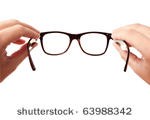
One of the ongoing themes of posts on this site is the well-documented view that people with learning disabilities are more likely to have difficulties with health issues and are less likely to have good access to healthcare to help them to manage those difficulties.
However, there is now a growing body of advice and guidance for health professionals on ways in which they can improve performance in responding to these issues and last week saw the launch of a guide for GPs and primary healthcare professionals aimed at offering better access to eye care for people with learning disabilities.
The guide was commissioned by the Royal College of General Practitioners, who asked the Royal College of Ophthalmologists to create a Best Practice Guide for GPs on Vision and People with Learning Disabilities. The guide was produced in conjunction with SeeAbility, who produced the excellent ‘Look up’ guides
Research by Seeability and the RNIB showed that adults with learning disabilities were ten times more likely to be blind or partially sighted than the rest of the population, with those with severe or profound learning disabilities being most likely to have serious sight problems. This latter group of course may not be able to verbally explain how their sight is affected, but the guidance points out that there may a number of non verbal indicators that suggest such people may be having difficulties with their sight, for example, eye poking or rubbing, persistently red eyes, discomfort with bright lights, undue alarm at unfamiliar noises or when approached – the guidance has a full list.
The research suggested that refractive error was the most common sight problem and that 6 in 10 people with learning disabilities needed glasses to correct vision. Clearly, something taken for granted by many people as an aid to better sight can be a major life change for many people with learning disabilities, but the guidance offers advice on ways to help people come to terms with this.
The guidance also draws attention to the new Community Eye Care Pathway for Adults and Young People with Learning Disabilities
which describes an enhanced sight test which can be delivered in community settings and suggests longer test times and opportunities for repeat visits to complete procedures.
The guidance says that everyone with learning disabilities should have their sight tested every two years, and that GPs should screen vision and hearing at annual health check to enable them to refer people to the relevant local services quickly.
You can read the full guidance here: Vision and People with Learning Disabilities: Guidance for GPs; Royal College of General Practitioners; Seeability; Royal College of Opthamologists
